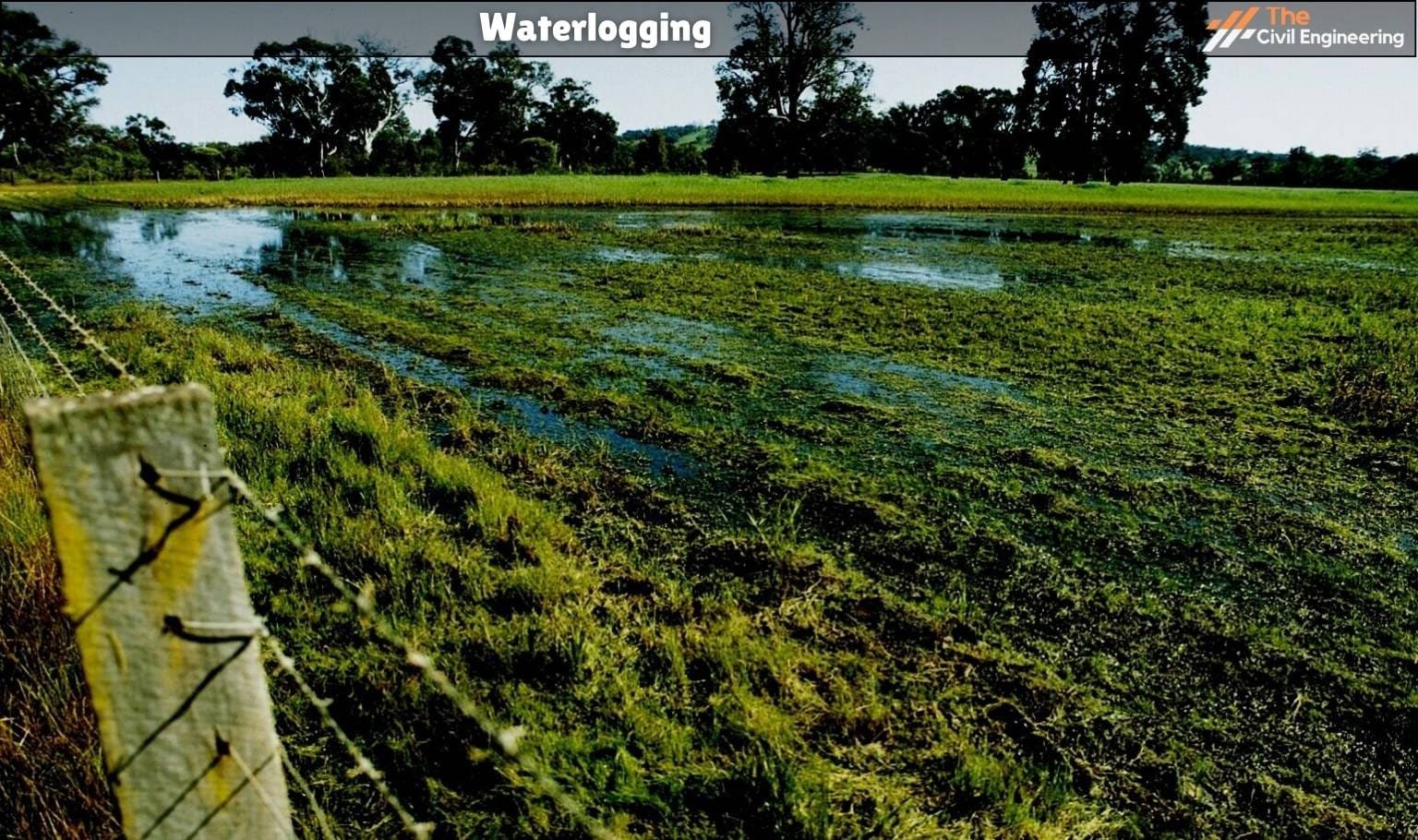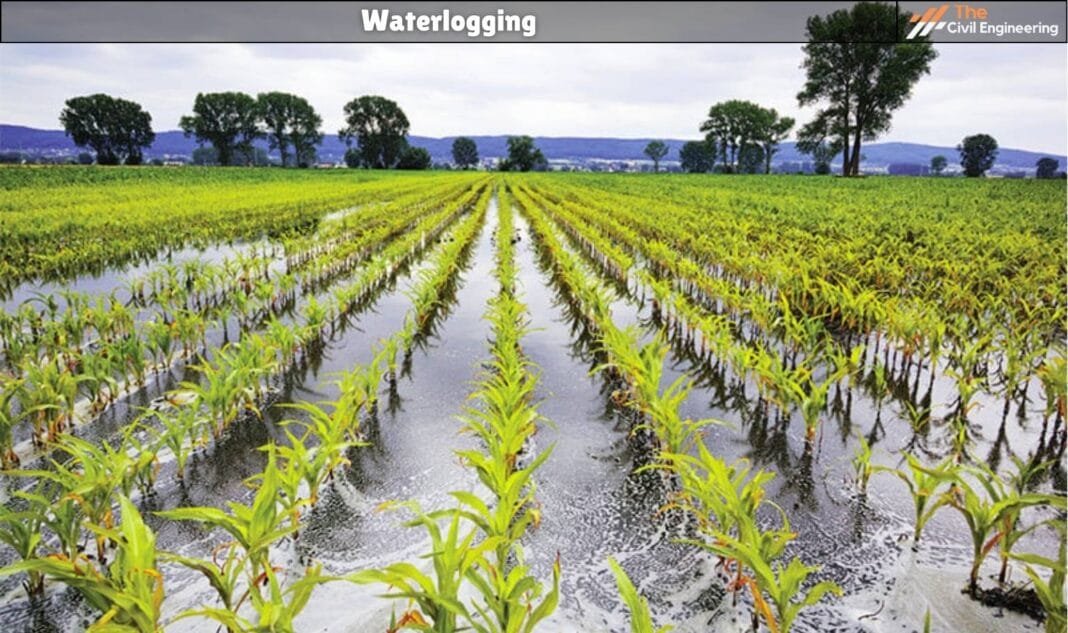Waterlogging is surplus water in the root zone accompanied by anaerobic situations.
Agricultural land is said to be waterlogged when the high water table affects its productivity. When the root zone of the plant is flooded with water, it becomes ill-aerated and hence reduces crop yield.

1. Causes of Waterlogging
The causative factors of waterlogging are as follows:
a. Over and intensive irrigation
If an intensive irrigation policy is made, the maximum irrigable area of the small region is irrigated. This leads to, too much irrigation of the region resulting in heavy percolation and subsequent rise in the water table.
For this reason, to avoid the waterlogging policy of extensive irrigation should be made.
b. Cultivation of wet crops in all the seasons and application of more water than required also increases the chances of waterlogging.
c. Seepage of water from adjoining highlands.
d. Seepage of the water through canals.
e. Impervious obstruction
If the water finds impervious obstruction on the way, the water table gets raised which causes the waterlogging.
f. Inadequate drainage
Soil having poor drainage qualities such as clay cannot drain the percolation water. This leads to the rising of the water table.
g. Inadequate surface drainage
If surface drainage is not adequate then there may be chances of waterlogging.
h. Excessive rains.
i. Submergence due to floods.
j. Irregular and flat topography
On a steep slope, water drains out quickly but on flat ground having depressions, the drainage of water is poor and water fills the depressions, which subsequently raises the water table.
k. Construction of reservoirs
Due to the construction of reservoirs, there is a rise in the water table in rivers which is responsible for the increment inflow of groundwater reservoirs, which finally causes waterlogging.
3. Effect of Water Logging
a. Crop yield reduction
The growth of plants depends upon the nutrients like nitrates which are produced by bacteria under a process called nutrification. These bacteria need oxygen for their survival.
The supply of oxygen gets cut off when the land becomes ill-aerated, resulting in the death of bacteria and falling in the production of their food which causes a reduction in plant growth, which reduces the crop yield.
b. The normal cultivation operations such as tilling, ploughing becomes difficult in waterlogged or swap area.
c. Certain aquatic weeds grow in the water-logged areas so it affects the growth of the main crop.
d. Rise in the salt content of soil or salinity of soil
If the water table rises up, water gets continuously evaporated by capillarity. Thus, an upward flow of water from the water table to the land surface is established.
With this upward flow, the salts, which are present in the water, also get raised towards the surface resulting in the deposition of salts in the root zone of the crops.
The concentration of these alkali salts present in the root zone of the crop has corroding effects on the roots, which reduces the osmotic activities of the plants and checks the plant growth, and the plants ultimately fade away. Such soils are called saline soils and the process of deposition of salts is called salinity of the soil.
e. Fall in soil temperature
Due to waterlogging the land remains submerged in water. Hence the temperature of the soil falls. Falling down the temperature suspends bacterial activities so there will be less availability of plant food.
f. Defective air circulation
In waterlogged areas, the supply of oxygen cuts off and thus bacteria die under anaerobic conditions.
g. Reduction in maturity period.
h. Adverse effect on community health.
i. Breeding places for mosquitoes.
j. Delaying in cultivation operations.
4. Preventive Measures of Waterlogging
It is clear that waterlogging can be controlled only if the quantity of water entering the soil can be checked and reduced. The various measures for controlling waterlogging are enumerated below:
a. Lining of the canal
Attempts may be done to reduce the seepage of water from the canals and watercourses. This may be achieved by the lining of canals.
b. Reducing the intensity of irrigation
In the areas where there is the possibility of waterlogging intensity of irrigation should be reduced.
c. By adopting crop rotation
Sowing wet crops (requiring more water) in every season should be discouraged. A wet crop followed by a dry crop i.e. crop rotation should be adopted.
d. By optimum use of water
It is a known fact that only a certain fixed amount of irrigation water gives the best productivity, less than that and more than that reduces crop yield.
e. Provision of intercepting drain
To collect the seepage water through the sides of the canal, intercepting drains shall be provided on the banks of the canal.
f. Provision of sufficient drainage system
An efficient drainage system should be provided in order to drain away from the stormwater and excess irrigation water. A good drainage system should consist of surface drains and subsurface drains.
g. By improving the natural drainage of the area
To reduce percolation, the water should not be allowed to stand for a longer period. This can be done by removing obstructions like bushes, jungles, and forests and improving the slopes of the natural drainage lines.
h. Adopting better methods of irrigation such as drip irrigation and sprinkler irrigation.
i. Lowering the full supply level (FSL) of the canal
Seepage from unlined canals can be reduced by lowering the FSL of the canal.
j. Introduction of lift irrigation
By using subsurface water lift irrigation should be adopted in place instead of canal irrigation, where there are possibilities of waterlogging. Lift irrigation utilizes underground water and hence maintains the water table at a lower level.
Read Also: What is a Retaining wall? | 12 Types of Retaining Wall
Read Also: Water Supply Engineering

